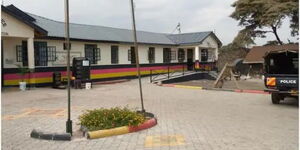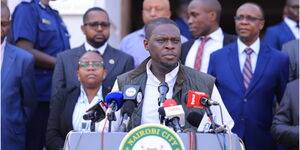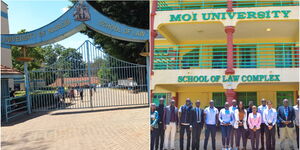When Muhoozi Kainerugaba threatened to capture Nairobi within days, he was called out and bashed before he issued an apology.
The takeover talk rings a bell when Uganda through under then President Iddi Amin threatened to annex all Kenyan districts that were part of Uganda before the colonial re-demarcation of the territorial boundaries.
These included Turkana, part of Lake Rudolf (now Lake Turkana), West Pokot, Tranz-Nzioa, Bungoma, Busia, Kakamega, Central Nyanza, South Nyanza, Narok, Kisii, Kericho, Nakuru, Uasin Gishu, Elgeyo, Marakwet, Nyandarua, Nandi, Kisumu, Eldoret, Tambach, Maji Moto, Maji Mazuri, Gilgil, Nakuru, Lake Baringo and Naivasha.
But how did this happen? Kenyans.co.ke took a trip down memory lane to revisit the times.
On April 1, 1902, the process to transfer the Eastern Province of Uganda to the East African Protectorate (Kenya) was initiated.
The areas in question lay approximately between the present eastern part of Uganda and a line running northward from a point where the boundary between British and German territory crossed.
The allocation of these districts was after foreign secretary Henry Charles Keith preferred to act on the advice of the foreign office official Clement Hill instead of implementing recommendations of Sir Harry Johnston, special commissioner in Uganda.
A number of factors fuelled the idea of transferring the territory to present-day Kenya.
Johnston’s responsibility was to find an administrative capital for both Uganda and the East African Protectorate (Kenya), having in mind that the two would be merged at one point.
At the time the seats of administration were at Entebbe for Uganda and Mombasa for the East African Protectorate.
In 1976, Ugandan President Al-Haji Field Marshal Idi Amin Dada attempted to redraw the boundaries of the two countries.
He claimed that these areas were very fertile and produced nearly all the wealth in Kenya.
On February 14, 1976, president Amin issued a statement in which he claimed he was informing the people of Uganda about their past geography.
He alluded that Uganda’s borders were beyond Juba and Torit in Sudan and all areas of western Kenya, up to about 30 km from Nairobi.
Amin equally stated that he had a written agreement signed by the then British colonial secretary of state Herbert Asquith, transferring some parts of Uganda to Sudan in 1914 and to Kenya in 1926.
At the time of his allegations, Amin was the chairman of the defunct Organisation of African Unity (OAU), which in 1964 had passed a resolution that all member states pledge themselves to respect the borders existing on their attainment of independence.
Had the colonial British administrators not given away some of Uganda’s soil, the whole of the Rift Valley Province and northwestern Kenya would today be Uganda.
It was through these claims that President Jomo Kenyatta threatened to block Uganda’s imports through the port of Mombasa.
In June 1975, Kenyan intelligence impounded a large convoy of Soviet-made arms en route to Uganda from Mombasa port.
The territorial claim was seen as the reason behind the arms import with the intention of declaring war on his neighbours.
Kenya and Uganda continue to enjoy a cordial and mutual relationship.












